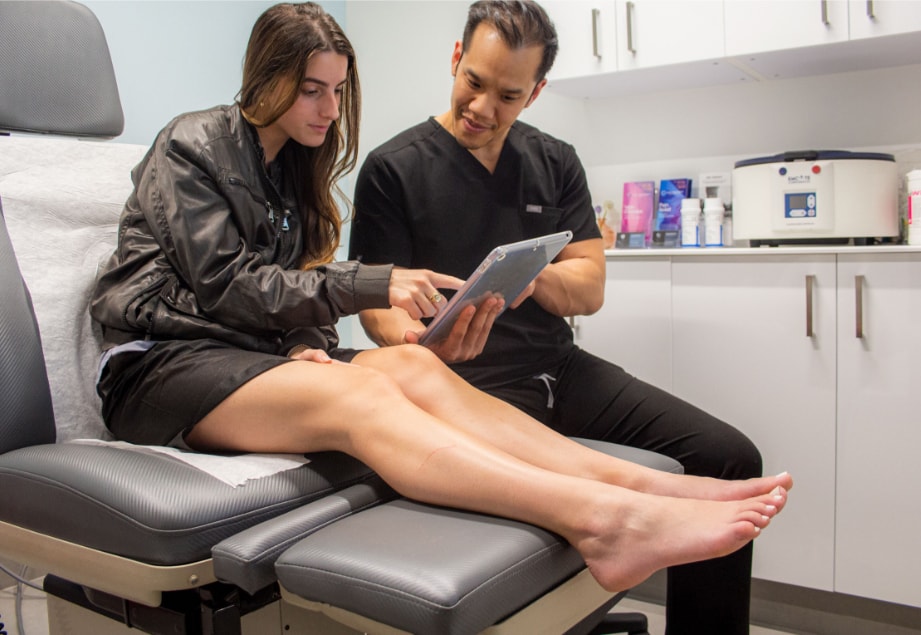What is laser therapy for spider veins?
Laser therapy is a non-invasive treatment for spider veins. It’s a popular cosmetic procedure widely offered at medical spas because it doesn’t have to be performed by a certified vein doctor or phlebologist. The laser therapy procedure involves channeling highly calibrated wavelengths of light energy into the damaged spider veins and blood vessels. The light energy destroys the diseased and unhealthy veins, making them get reabsorbed by the body. The procedure yields results after several sessions spaced a few weeks apart.

The Vein Treatment Clinic generally recommends sclerotherapy and other minimally invasive treatments for spider veins. We only recommend laser therapy for patients with extremely thin spider veins on the face or feet. That’s because laser therapy for spider veins also includes several limitations — it can’t address the root cause of spider veins, and it involves a high rate of recurrence. Below, we provide a comprehensive overview of laser therapy for spider veins.
If you have spider veins, please schedule an appointment for a diagnosis and treatment.
Benefits of laser therapy for spider veins:
- Non-invasive treatment
- No incisions or injections
- No pain or discomfort
- No harsh side effects or complications
- Concludes within 30 minutes
- Can remove extremely small spider veins
- Suitable for spider veins on the face and feet

Drawbacks of laser therapy for spider veins:
- Can’t treat larger vein problems
- Doesn’t identify or treat underlying vein disease
- Usually performed by cosmetic specialists without specialized training in vein care
- Produces mild results after multiple sessions spaced weeks apart
- Only suitable in extremely limited cases
- High rate of spider vein recurrence
What are the side effects of laser therapy for spider veins?
Laser therapy involves minimal post-treatment side effects. This procedure removes the broken capillaries on your legs, following which you can resume most of your daily activities and work immediately. You might feel a slight warming sensation, mild discomfort, and redness in the treatment areas. But there are no harsh complications.
Who needs laser therapy for spider veins?
Laser therapy is generally ideal for patients with spider veins on the face and feet. The face and feet contain dense artery-vein connections. Laser therapy only affects extremely thin, broken capillaries on legs, and it can avoid the arteries and larger veins. When used on the face and feet, this treatment can remove the unwanted spider veins without affecting the arteries, making it extremely safe and reliable.
What to expect from the laser therapy procedure?
You might not notice significant improvements for several weeks after laser therapy. Most patients need multiple sessions spaced a few weeks apart to see desired results. The treated area might look pink or red for a few hours after laser therapy, and you might experience a mild stinging sensation, similar to a sunburn. The sunburn sensations usually dissipate within a few hours. You may also experience mild post-treatment swelling for a few days.
The following are some post-treatment aftercare guidelines to improve recovery:
- Apply cool packs or moist cloths to the treatment area to reduce discomfort.
- Don’t apply makeup or lotion to the area for at least 24 hours.
- Apply a moisturizing lotion to the treated area at least twice a day for at least 3 months after the final laser therapy session.
- Walk frequently, and avoid sitting or standing still for extended periods. If you have a desk job, take short walking breaks every hour.
How long does it take for spider veins to disappear after laser treatment?
The number of sessions necessary to remove all the spider veins depends on your unique goals and requirements. Depending on the location, size, and density of spider veins, you may need 4 sessions or more, spaced a few weeks apart. The entire procedure may take several months. Furthermore, laser therapy isn’t the most reliable spider vein treatment, so many of the spider veins may remain on the skin’s surface even after all sessions are complete.
Why do vein doctors advise against laser therapy?
Vein doctors generally advise against laser therapy because it’s extremely ineffective and inefficient. You need multiple sessions spaced several weeks apart to notice mild improvements in the appearance of your legs. The risk of recurrence is also extremely high — many patients notice new spider veins shortly after laser therapy. Furthermore, laser therapy can only work on the tiniest of spider veins and broken capillaries on the legs.
Laser therapy is popular because it’s pushed by cosmetic providers and aestheticians in medical spas. But vein doctors generally prefer sclerotherapy and other minimally invasive procedures that destroy the diseased spider veins completely, ensuring safe and long-lasting results. Laser therapy is only preferable for spider veins on the face and feet, i.e., regions with dense artery-vein connections.
Sclerotherapy: the best spider vein treatment?
Sclerotherapy is widely considered the best spider vein treatment. Sclerotherapy is a minimally invasive procedure wherein a sclerosant medicine is carefully injected into the unhealthy spider veins and thick veins on the legs. The sclerosant medicine seals the spider vein’s walls, turning them into hardened scar tissues eventually reabsorbed by the body. Each spider vein receives one injection, so the total number of injections depends on the number of spider veins.
What is better for spider veins: laser or injections?
Sclerotherapy is undoubtedly superior to laser therapy for spider veins. Sclerotherapy guarantees results. Each injection successfully removes one spider vein, turning it into a hardened tissue that’s eventually absorbed by the body. Most patients only need two sessions to remove all of the unwanted spider veins.
Once the spider vein is gone, it can’t return (though you may develop new spider veins). Sclerotherapy is also performed by specialized vein doctors, so they’re more likely to identify and treat the underlying root cause of spider veins — venous insufficiency. Laser therapy is only safer than sclerotherapy in one aspect — treating spider veins on the face and feet.








